African hunting shooting sticks are universal in Africa. This is because most hunting in Africa is from a standing position. This article combines information on African shooting sticks and the client’s recent experience as a first-time user of African shooting sticks.
We are currently using Rudolph quad sticks for our African shooting sticks. The quad sticks give significantly more stability and facilitate far longer shots. The preferred style of Rudolph is the one with a flat forearm, allowing a little extra opportunity to move the rifle without having to move the sticks completely.
Quad Sticks can be purchased for $129, and we recommend buying some and practicing a lot with them. The quad sticks take some getting used to and, in particular, do not lend themselves to solo hunting. But remember, in Africa; your guide will be carrying the African shooting sticks and placing them for you. Set out below is a quick recap about shooting sticks in Africa.
Hunting with African Shooting Sticks
Shooting sticks are often new for the first-time African hunter.
A three-legged shooting stick is a tripod to rest your rifle for support while taking a standing shot. Prone, sitting, and kneeling shots are not that common. Because of:
- The low vegetation obscures your target.
- Lying in a prone position or kneeling can be very uncomfortable. Also, it may not be possible because of rocky terrain, thorns, and other impediments.
- Furthermore, shots in Africa often need to be taken relatively quickly. Consequently, shooting sticks and a standing position facilitate this.
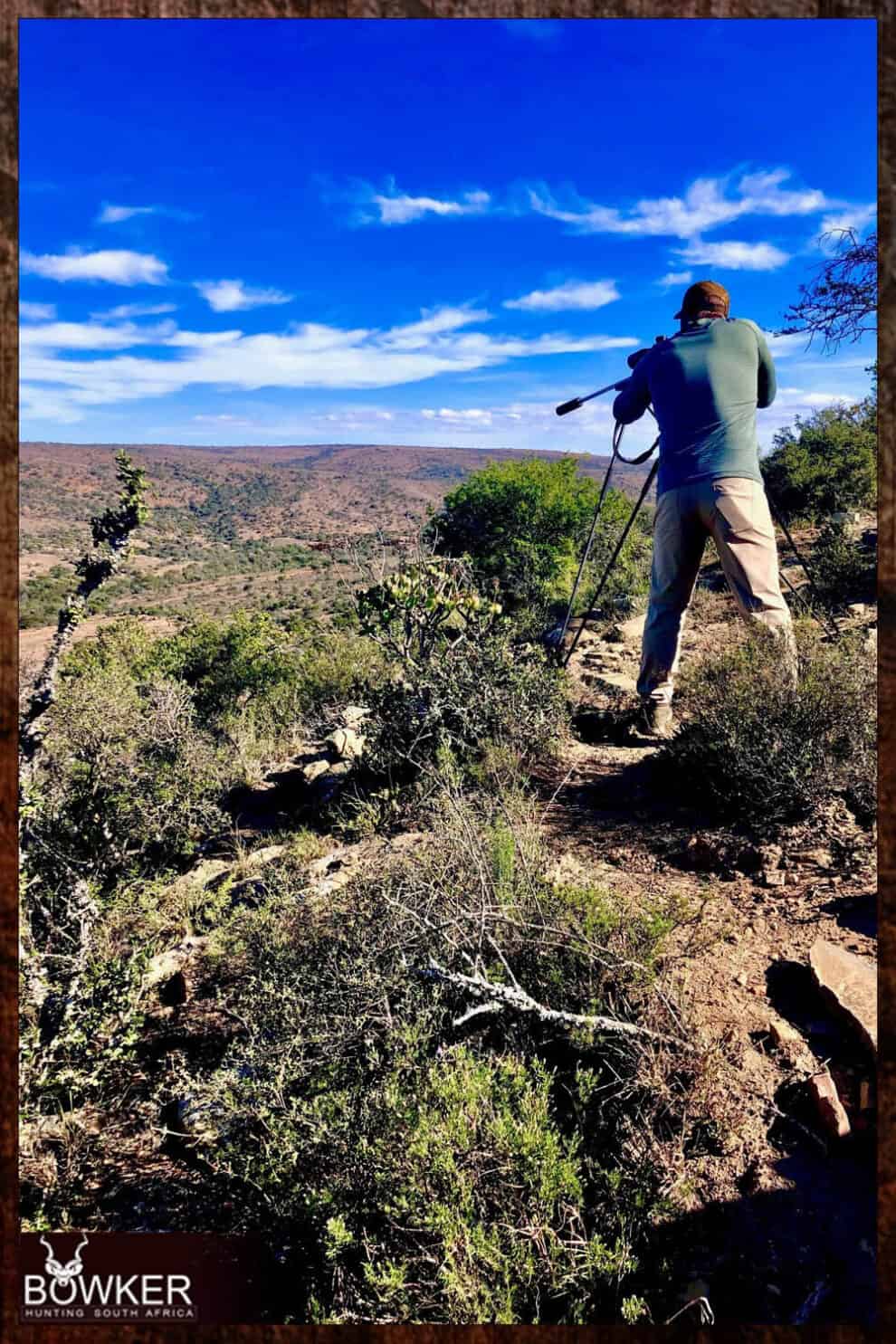
How do African shooting sticks work in practice, and how should I prepare?
- The Professional hunter will carry the sticks or tripod for the first-time African hunter. He will walk in front, followed by the tracker and the hunter.
- The professional hunter will place the African shooting sticks for the hunter when the moment arrives.
- The hunter will then place his rifle across the shooting sticks, and the professional hunter will move over to the side.
- Historically the African shooting sticks were homemade by the Professional hunter.
- These days shooting sticks are readily available, durable, and light, often made of titanium.
- Many materials are available on the correct methodology for using shooting sticks on YouTube. The right way is probably the one that works best for you.
- Buy some shooting sticks. PRACTISE A LOT WITH SHOOTING STICKS.
Client Hunting experience with African Shooting Sticks
Flights and COVID-19 testing
I just got home yesterday (Friday, April 30) from my first South African hunting trip with Nick Bowker, Hunting South Africa, and I had an excellent trip.
This trip was initially slated for July 2020, and I fitted the hunt this year despite the uncertainty of traveling with Covid 19 issues.
I am happy to report that it was not difficult to have the RT-PCR test conducted before traveling and before I returned from South Africa.
More details are a little further in this report. I’ll do a continuing commentary on a day-by-day happening.
I flew British Airways from Cincinnati to Washington, DC, on a Saturday, then flew Ethiopian on the following Sunday to Addis Ababa, then on to Johannesburg, South Africa.
Monday evening was spent at Journeys in Africa; then I flew to Port Elizabeth, SA, on Tuesday morning, where I was met by my PH, Ben, and driven to Olivefountain Ranch, near Bedford (about a 2-hour trip).
Arrival
I got to meet everyone at the ranch, sight the rifle I would be using, and go out looking over a small part of the ranch for a bit.
I had a very lovely two-room cottage with a big, comfortable bed and a massive bathroom for accommodations for my visit.
Evenings were spent with everyone over appetizers, then great dinners, drinks, and conversation. I enjoyed Castle Lite and SA red wines. And no TV for almost two weeks was a big plus!
Rob Bowker had arrived the evening before and offered to be the Land Cruiser driver and help with spotting. This was a big plus.
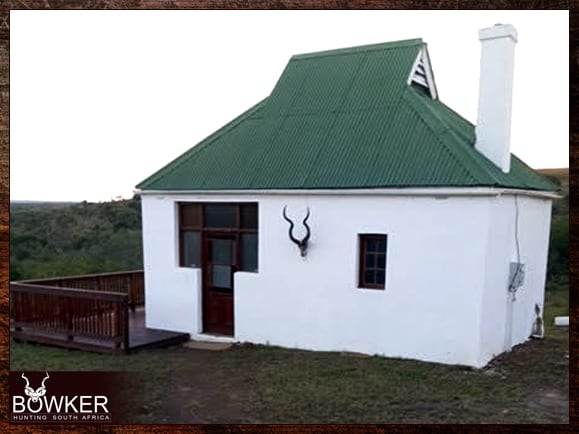
Impala hunt
Day 2 was my first full day at Olivefountain, and Impala ended up as the first animal of my eight-animal safari (Impala, Kudu, Nyala, Black Wildebeest, Springbuck, Warthog, Blesbuck, and Mountain Reedbuck).
Ben set us off on a stalk along a scrubby hillside for impala. Several rams were visible, but not what he wanted to find. I was able to see these animals up pretty close.
I followed Ben across a hillside, trying to be quiet. We moved to another area with a thicker cover, and several more impala were spotted, and a stalk was set up. I realized more exercise should have been in my pre-hunt plans.
A young impala ram stepped out between the intended group of older rams and us. He stared at us for at least ten minutes before we could move around him. I thought for sure this would be the end of our stalk.
The group would appear and then move behind other acacia trees. We had to keep cutting around trees and keep an eye on the young ram.
Finally, we had a window to look over the older rams, and Ben told me which one I should take. A porcupine popped out in front of us and ran past. Fortunately not giving us away (but great to see one).
My First African Trophy
The rifle went up on the African shooting sticks. Man, I was nervous and tried to settle down for the shot. I fired, and the ram was hit and ran off in poor shape. I fired a second round to no effect, and he fled into the brush. Ben assured me he was hard hit and wouldn’t travel far.
Lots of blood to track. Black Jack, the terrier, and one of the beagles were let loose, and the impala was found quickly.
I was thrilled to have my first African game (it was surreal, honestly) after shooting white-tailed deer for nearly all of my big game hunting experiences.
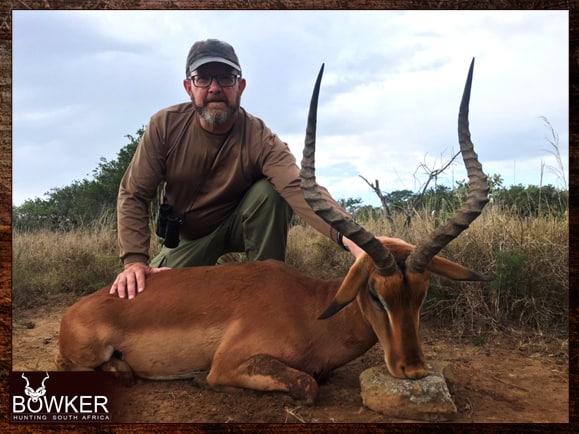
Using African Quad Shooting Sticks
This is probably a good spot to mention what equipment I was able to use on my trip, as I didn’t bring a rifle of my own (I didn’t want the hassle with it, and the use of an outfitter rifle and ammo as part of the hunting package was pretty appealing).
Nick provided a Sako 85 chambered in 300 Winchester Magnum with a Swarovski dS 5-25x52P range-finding scope. Handloaded rounds were Hornady 180-grain ELD-X bullets.
A big plus was having a suppressor, which took away the recoil and report; I loved shooting this rifle.
The African shooting sticks were Rudolph quad sticks, which I didn’t like to start with.
Still, after some serious and helpful constructive criticism on my shooting stance and shooting techniques by Ben and Rob, it got me shooting at distances I would not have thought possible.
My average shooting distances on white-tailed deer in Kentucky are well under 100 yards, so this was new territory for me.
It’s probably helpful for your PH to know all this in advance; a dumb error on my part.
I brought my Zeiss Victory T-fl 8×32 binos; good for birdwatching here in the US but lacking for looking at the big game at a long distance; 10x is much better. I’ll be better prepared next time.
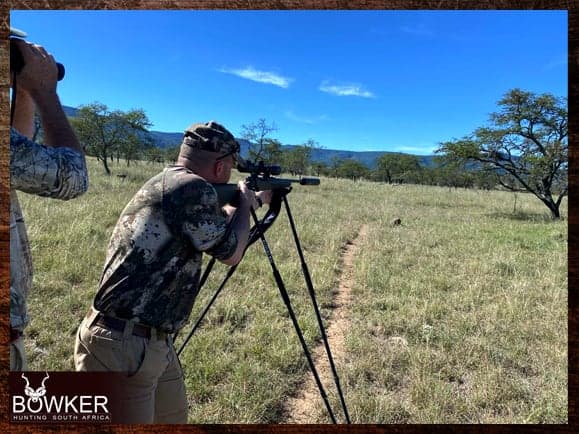
Mountain Reedbuck hunt
Later in the afternoon, we were after Mountain Reedbuck, of which I saw plenty on the ranch. We had several big thunderstorms to work around after locating a ram with several ewes. A stalk was made, but the little cover was to be had in a large field; the group leaped to the hooves and ran off but stopped several hundred yards away.
I tried a shot, but it ended up as a poor hit; I missed the second shot, and off he ran. Searched until it was too dark to see. I was disappointed not to locate the ram that evening and the following day. Pretty bummed about my shooting. It was tough not to think about. I should have passed on that shot.
Nyala hunt
After searching the next morning for the reedbuck, later in the 2nd day went searching for a Nyala – this was an animal I truly wanted to hunt (as well as Kudu). We traveled to the top of an escarpment overlooking an enormous floodplain that had a lot of trees and shrubs, as well as open grassy areas.
We had a baboon sentinel barking at us for quite a while until we moved out of sight on the hillside. Lots of kudu and nyala cows were moving around to view. Suddenly, four Nyala bulls emerged in a large, dense thicket with openings.
Several cows ran to this group, and some posturing with the bulls started. The biggest bull stepped into the open, and I was told to take him. The first shot struck high in the spine, and when he was down, another shot was put into him.
Beautiful animal to take home! I was excited to see and get my Nyala. Very scenic area to be able to hunt. We visited this valley later for another client’s Kudu.
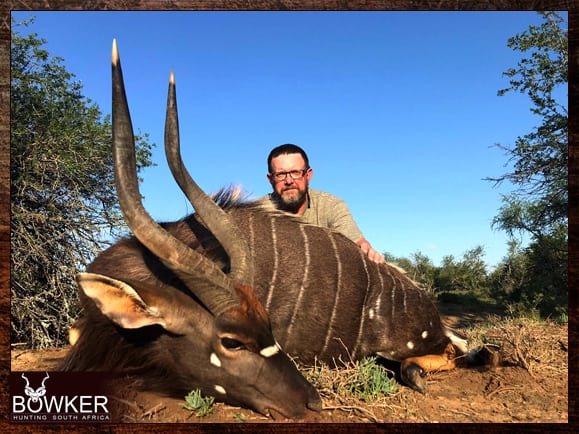
Kudu Hunt
After hunting the Nyala, an opportunity to hunt a property further away came up for Kudu (a large cattle and sheep ranch north of Bedford) through an acquaintance of Ben. So we hit the road at about 4.30 am (a 2-hour drive) near the Winterberg Mountains (I think) at a higher altitude. Kyle Brown (property owned by Kenny Brown) accompanied Rob, Ben, and me with several trackers.
We had a bit of fog, so we waited to clear before moving off to view down into grassy and tree-covered valleys. We located a young Kudu bull with a cow but not much else, so we moved some distance away to another sizeable grassy plain.
An absolute stud of a Kudu was seen chasing a cow a long way off, and a stalk was planned and begun. I’m not sure how far, but when South Africans start walking, they cover the ground. I made a big loop to come in behind this Kudu. Snuck through a few cattle, which ignored us thankfully, and began approaching a thicket where the Kudu had been seen earlier.
This was very slow and painstaking at this point. A kudu was in front of us, but it wasn’t the larger bull. We watched for a bit and started moving forward when suddenly (of course), a young kudu bull resting behind a bush stood up 50 yards in front of us and gave us the stinkeye. We waited, but the stalk was blown, and off he ran, as well as any other kudu nearby.

Afternoon Kudu Hunting
After this event, we took a quick lunch break and went off to another section of the ranch where we could walk the ravine edges and view the bottoms. I immediately started seeing kudu cows on the far side of the valley, and kudu bulls started chasing them further down to a wooded section. There was Kudu everywhere!
Pretty exciting to see. I watched two bulls start sparring, and they went at each other. A large bull began walking up the far side (450 yards away), but I was not confident of a good shot on that animal. We eventually moved off the hillside. I got my tutorial on properly using the quad shooting sticks with the Sako and felt much better, practicing some dry fire shots.
It was pretty warm at that point, and it was not easy walking, rocks upon rocks, and my feet were sore. We drove back to where we had seen the big Kudu bull on the grassy plain earlier in the day to scope the surrounding area.
My First Kudu
Ben and Rob had walked away from the truck to look at that area (I was still by the truck) when in the distance, there was a windmilling arm belonging to Ben urging us to meet them 200 yards distant. Trying to cover 200 yards quietly and quickly was not easy!
Sticks were already up, and I threw the rifle on them, and Ben was trying to tell me where the Kudu was, and I arrived out of breath. I wasn’t seeing it (because it was much farther away than I realized).
A curse came from Ben, and Rob grabbed me and the African shooting sticks, dragged me several feet left, and whispered where the Kudu was after moving farther away….these guys were calling out the distance to shoot.
I laid the crosshairs of the Sako 300 win mag reticle on the Kudu. I hit the rangefinding button on the scope…479 yards…a whisper in my left ear, “if you’re not comfortable, don’t shoot, we’ll find another,” but I don’t know what you call it (Zen?).
Still, that bull was broadside, a soft glow of the setting sun behind it, and something clicked in my head; I brought the adjusted crosshair up the foreleg, and suddenly the trigger broke clean.
Lost the animal in the scope and heard Rob say. “He’s hit – and down!”.
What a relief
Ben took off running with two trackers to ensure all was good, and the shakes started.
That was the longest walk of my life, seemingly taking forever, with some backslapping and many handshakes.
Massive and magnificent animal! Many pics were taken, and thank the Lord. The Land Cruiser could be driven up to it.
The ELD-X bullet went through the leg, through the heart, and was just beneath the skin on the offside shoulder. We returned to the farmhouse to drop Kyle off and show his father.
I enjoyed a celebratory Castle Lite or two and headed back to Olivefountain. It was the longest 2-hour drive ever!
We met everyone when we got back, and more celebration with dinner, beer, wine, and Gentleman Jack. I slept like a dead man that night (but a delighted one).

Duiker and Steenbok sightings
Following the Kudu adventure, I felt rough from a long day, had good drinks, and was somewhat dehydrated.
Today we would look for a good warthog in the morning and see what could be found. Very foggy this morning. No big rush to get out and view the hillsides.
There was a nice solitary Springbuck ram that frequented the head of a valley not far away from the lodge we visited first. We started a stalk but were busted quickly as soon as we saw him. He was off for the races.
Springbuck is everywhere on this ranch.
The fog started lifting in the valleys, so we headed lower to scan the valleys. Saw a nice Common Duiker, but it wasn’t on my list (some regret later, there were numerous duiker and steenbuck sightings every day on the ranch, and I didn’t consider them earlier).
A neat critter was found two on the road-the Karoo earthworm. 3-4 feet long!
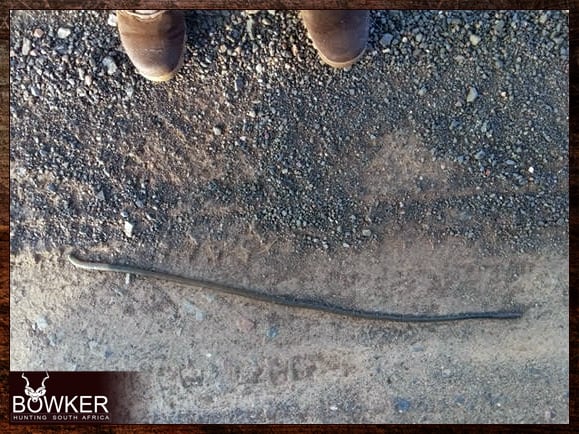
African shooting sticks and Warthog Hunt
After the earthworm encounter, we found an excellent hillside to view from. I’m amazed at how similar the topography is to southeastern Arizona. We saw a flock of helmeted guineafowl first, next, a sow warthog with several piglets. Warthog is here in good numbers.
Ben explained that good boars are always a target species, and I saw several big boars throughout my stay. Scanning the hillside with our binos, suddenly, a giant boar ambled out of the brush in a clearing. I couldn’t tell how good the tusks were, but I could see them pretty well.
Ben thought we should pursue this one, so we moved down our hillside but were stymied by a thick band of trees and brush below us-the odds that other warthogs would be in there and we’d spook them were pretty high. Over 300 yards away.
He put the African shooting sticks up and asked me if I felt confident with the shot after the previous day with my Kudu. I felt very confident. The rifle went up, the hog was broadside, checked the range, and let the Sako loose. He ran 20 yards and rolled over, kicking. It sounded like a watermelon being thumped.
We threaded through the brush and soon were next to him. I’ll admit warthog was not a big “get” for me, but after seeing him up close was happy I got him. They are odd animals. I think warthogs say “Africa” much or more than most animals. Another super animal!

Blesbok Hunting Area
The afternoon was leisurely spent looking for an older Springbuck closer to home or another Mountain Reedbuck, but nothing suitable for a stalk. We saw a big Waterbuck keeping company with a cow on the other hunter-in-camps list. It was too late for him to make a stalk until the next day.
I tried to identify a few birds (I saw a couple of Pale Chanting Goshawks being mobbed by Lapwings) and lots of LBJs (Little Brown Jobs) flying around. Blue Cranes must like this habitat as we’ve seen several and would see many more. Their calls sound identical to our Sandhill Cranes here in the US.
The next day (starting to lose track now since every day was a new experience), we were going to Nick’s father’s sheep ranch located west of his ranch. This area was expansive grasslands with gently rolling hills, many termite/ant mounds, and very few trees or shrubs.
Lots of springbuck and blesbuck here. We drove through numerous gates to get to areas to hunt Blesbuck. I had been told these antelope were very wary. Shots would need to be made at longer distances with no cover on stalking approaches. The Land Cruiser was parked below the ridge crest, and Ben and I headed forth with rifles and sticks in hand.
Scanning the grasslands, we spotted two older white bulls, which Ben determined would be good first choices to put a stalk on. The first one was not having it and paced off out of range and stood watching us.
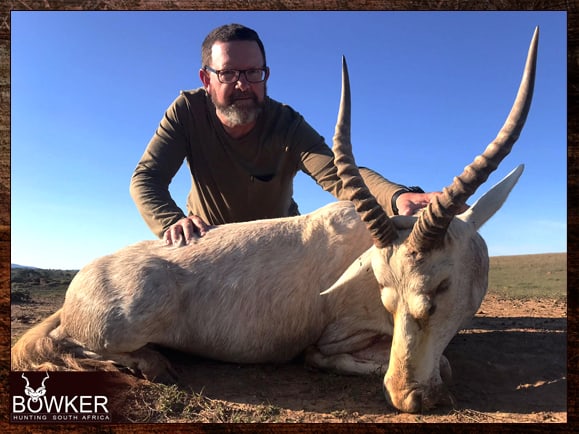
White Blesbok Hunt & African shooting sticks
The second bull had run off behind a dam embankment, and we had lost sight of him. As we walked downslope to look at other rams scattered over the grasslands, he appeared, headed toward the first bull, 300 yards out parallel to us. Ben had the sticks ready quickly, and we watched as he trotted, then slowed, then trotted again,
Finally, he paused with a quartering on the shot, and the Sako spoke, bullet punched through, short-run and down. These are very muscular antelope. Ben mentioned that a less-than-optimal strike on one would result in a long chase. These look more goat-like than any other antelope I looked at up close.
The Blesbuck was field-dressed after photos were taken. We headed in the cruiser towards the top of a ridge to see what might be in the next grassy expanse when Ben pointed out the head of a snake above the grass, which was a Boomslang, we jumped out for a better look, but it retreated into a large clump of grass.
A little further on, we found a giant Leopard Tortoise. Pic attached. I hoped to see one of these, a lovely find! I tried a shot on a Common Blesbuck at 400+ yards at the crest but shot under. We watched a group of Blesbuck and could not find a wounding strike. We returned to Olivefountain for lunch and a break to return later in the afternoon.
Common Blesbok Hunt
After lunch and a relaxing break, we headed back to Nick’s father’s ranch for the afternoon to look for a Common Blesbuck. Typically the temps would be a little warm (no jackets needed) by early afternoon and then begin cooling off into enjoyable and dry conditions.
I had brought plenty of thermal undergarments and never wore any. April temperatures make for a beautiful month in this area.
The afternoon hunt was going to be a long stalk, as we did not see what was wanted for a Blesbuck, and we left the Land Cruiser far behind and started hiking up a long, gentle grassy slope to the horizon.
A blesbuck was sky-lit in the distance but not in a proper shooting position, and it ran off as we grew closer.
Once we reached the top of the rise, we startled a herd of sheep, which thundered off but surprisingly did not upset any blesbuck.
We could see multiple heads bobbing at each other over the rise, a big problem. There wasn’t any cover over knee-high.
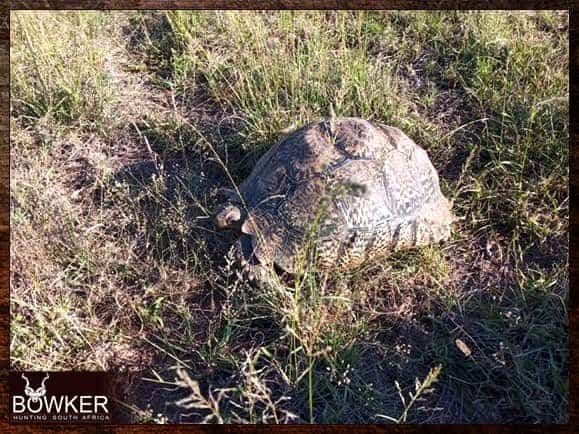
Common Blesbok Stalk
I stayed directly behind Ben as we moved into the wind (always). We were in plain view with almost a semi-circle of Blesbuck and more sheep around us.
Off to our right were a Common and a White Blesbuck about 300 yards away. Walking towards us, grazing as they walked.
A small group of sheep began closing a gap behind the Blesbuck, so the decision was made to set up for a shot before they got too close.
I was waiting for the Common to stop lifting his head for a chest shot, but he never stopped grazing and walking.
I hit him in the neck before the shoulders and dropped at the shot—a beautiful animal, even with the Satan horns. Ben walked back to bring the truck.
I sat and enjoyed looking over the Blesbuck and enjoying the quiet.
Incredible not to hear any human-made noises out here. After pics and loading the Blesbuck, we looked briefly at the many springbok and returned to the lodge for another beautiful evening around the braai.
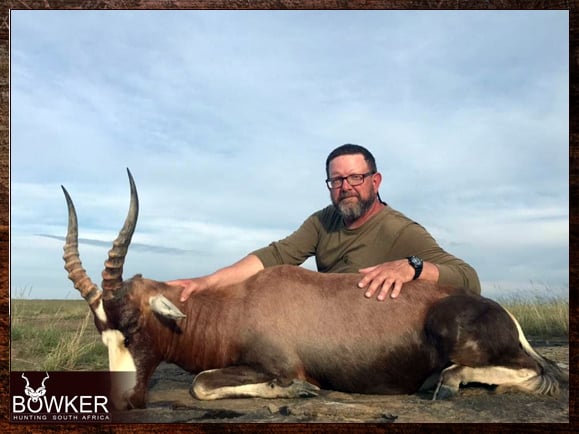
Black Wildebeest
This was when I started thinking about the end of my safari. Just a couple of animals left to hunt. The days seemed to transition smoothly from one day to the next. I liked that. Since I had originally started looking into an African safari, the last two years had not been great (except for the birth of my first grandson); my Mom passed away suddenly right before Christmas 2018.
Covid happened, and we lost employees at work, so travel and workload became ridiculous; I was determined to have this trip work out no matter what! I thought about this trip every day.
Happy to be here but a little solemn over having it end. 8 hunting days were not enough!
Earlier, I had kidded Ben and Rob. It went something like them, stating, “today will be a nice day to go find a (insert animal name here).” And it nearly always happened that way. Well, today, it was finally going to be a Black Wildebeest.
We had seen one or two earlier. It is a comical animal, spinning and gyrating around for no apparent reason. I like the appearance of the sweeping horns out in front of the bases and the long, flowing whitetail.
African shooting sticks and Black Wildebeest Hunt
We traveled nearby to a neighboring farm, which was very open grassland studded with termite mounds. Not long into our travel, a group of wildebeest was spotted a good distance away, watching us.
Sticks came out with the rifle, and we began moving towards the small herd, which appeared to be a bull with several cows.
They grew increasingly active as we began our approach, spinning around a bit. The cows seemed ready to vacate the area, but not the bull. I’d see why shortly.
We probably made it within 400 yards, and the group of cows ran off but still watched while the bull faced us head-on, occasionally pacing off and returning to the same spot.
It didn’t look like he was going to offer a broadside shot, so, at 375 yards, we put the rifle on the sticks, and as he held still, watching us, he pulled the trigger, and he was down in an instant.
After another long walk to see him up close, we found a big Mountain Tortoise on our way there. I was very pleased to see both of these animals up close.
Bull wildebeest have a spot in their territory where cows visit them, not vice-versa. Because the ground was pawed clear of grass and piles of scattered dung all around this spot.
The horns are pretty impressive. These were pretty rough and scarred up. Another great animal!
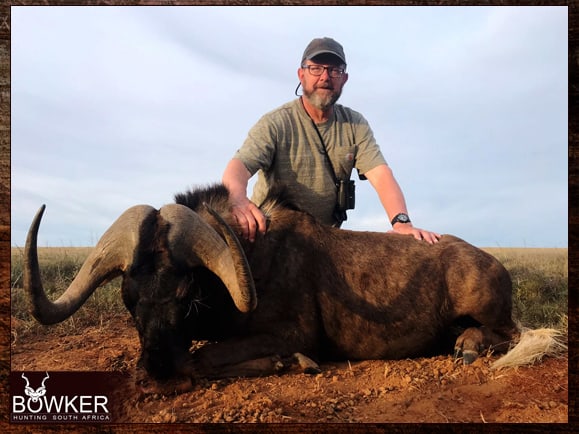
Mountain Reedbuck Hunt
I also got another opportunity to redeem myself on a Mountain Reedbuck later in the day after the Black Wildebeest was brought back for skinning; we traveled to a hilly, rocky area with shrubs and mixed grasses, where a ram and ewe reedbuck were soon spotted (and they spotted us), running down the hillside before the sticks could be put up.
We moved downslope to try to locate them, not seeing them, when they leaped out of a dip in the land before us and ran downhill further, but this time stopped to look back; the first shot hit low, not fatal, but the follow-up shot was good, and the ram was down. The fluffy white tail reminds me of a cottontail rabbit as they run away. Pretty and delicate antelope, another nice trophy.
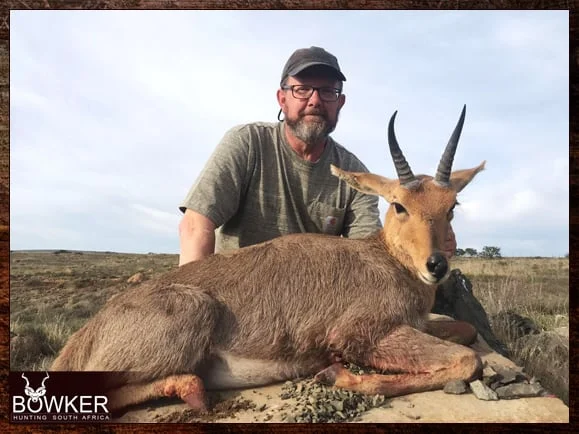
Birding while hunting
Besides wanting to hunt and see all of the spectacular antelope (plus warthog), I had high hopes to see lots of other wildlife, smaller stuff, birds, reptiles, all of it. On arrival day, after a brief rain, many winged termites began emerging, fluttering around.
We got to see an aardwolf running around in a field, catching them as dusk was approaching; we saw another on the gravel road back to camp another night.
I saw plenty of yellow mongooses, a pair of bat-eared foxes, and a banded mongoose (plus the porcupine when hunting the impala). Rock Hyraxes were commonly seen. I would have liked to have seen an aardvark, many hollowed-out termite mounds, and dug-out burrows. I liked seeing the Boomslang and the two tortoises, but I would have also enjoyed seeing a puff adder and Cape Cobra.
Birding was good, with lots of Blue Cranes around; we saw 4 Secretary Birds where we hunted the Blesbuck, having a territorial fight, then an odd mating ritual (a pair would race side by side for a hundred yards or more, turn, the male would leap onto the females back, then off, then race off with wings outspread back to where they started…just guessing on the mating part.
Saw Kori Bustard (2), a group of Crested Kouran (I believe), and lots of Ant-eating Chats on termite mounds. Rock Kestrels were common, and very nice to have Fiery-winged Nightjars singing by our braai nearly every night.
We would hear Black-backed Jackals in the mornings and black-headed orioles around the house with Acacia Barbets and African Hoopoes.
Saw plenty of Glossy Starlings. What a beautiful bird in the sun, looking like it was plated in blue chrome, with bright red eyes.
Springbok Hunting Area
Later in the afternoon, we went out looking for a nice ram Springbuck. The weather is calm and cooling off, starting to become somewhat overcast. We drove a bit and began glassing large grassy fields dotted with termite mounds. Well, Ben and Rob did, my 8x binos not being much help.
There were large draws that you could easily miss animals, so driving to all points was helpful. We ended up in an area where the land flattened out below a large and long ridge, with lots of common springbucks, and saw white, black, and copper springbuck. Common was on my list, and I wanted real South African national animals. We just started walking to see what was out and about.
Seemingly every animal had a comfort level, and at 500 yards, they became very alert. At around 400 yards out, they started moving. We tried angling towards a good candidate, but off he went. The next one was a little more cooperative. We angled left but maintained the same distance, over 400 yards.
African shooting sticks and the Springbok Hunt
I tried the rifle on the sticks and constantly kept shifting the sticks. The ram would walk and pause briefly. As soon as I began to get set, he was on the move again. Finally, we decided to stop to see what the ram would do next.
His little jaunts became shorter, and he would pause quarter-facing on, finally anticipating him stopping and left fly the bullet. I think I accidentally ranged a termite mound in front of him, as Ben had him at over 400 yards while I had him at 340 yards. The bullet struck a little low, but after a short run, the ram was done.
I’ve seen videos where they talk about the smell of a Springbucks back, I tried it, and it reminded me of toasted marshmallows. Beautiful animal. I enjoyed seeing groups of them racing around all week. Last animal… the trip is done. Happy but a little bummed out. And a nice sunset.
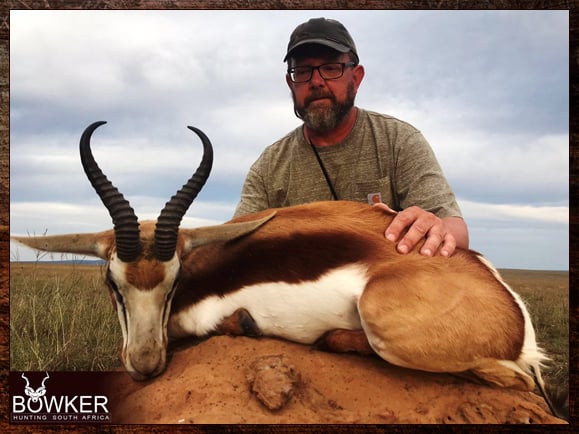
Covid Test
On my last full day, I rode around as an observer/spotter for a father/daughter group hunting at Olivefountain, which was fun watching others stalk their game.
We watched a long and successful stalk on a kudu bull, springbuck, and some blesbuck culls.
Early that morning, I had to go to Grahamstown, about a 45-minute drive, to have my Covid RT-PCR test done to fly home the next morning.
So we arrived as the clinic opened (8 am), had the test sample taken (the deep nasal one, I think I left finger impressions in the chair arms), Ampath Labs did the analysis, and we had it emailed 12 hours later so it could be printed out that evening.
The only point I had to show my Covid test results was when I arrived in Addis Ababa, Ethiopia. From what I remember, I didn’t have to show them when I arrived in Chicago. So I flew from Port Elizabeth, SA, to Johannesburg, SA, filled out a Covid questionnaire to board my next flight to Ethiopia, then transited through Addis Ababa for the big leg to Chicago (a brief stop to refuel in Dublin, Ireland).
Clearing Customs in the United States
I had a Customs form and Covid questionnaire on the flight for Chicago, all that was requested to be turned in was the Customs declaration; I had a couple of questions regarding what I did in SA and was asked if I had any wildlife products (none), and that was it.
Going through the Covid testing process was not that difficult. I had easy access to get testing done near my home (plus a clinic at the Greater Cincinnati Airport with quick results) and easily done at Nick’s ranch.
I wish I had known how straightforward it would be. If that is what might be holding up your decision to go this year or next year, I would reconsider it.
I had a very satisfying trip. I’ve already booked a cull hunt plus a couple of larger antelope to hunt for July 2022.
Everyone at the ranch was enjoyable to spend time with. I certainly felt at home. I already missed the meals and loved the daily cleaning and laundry service.
I have to do all those things here at home, so nice to have a break from that. Please get in touch with me by PM if you have any questions about my trip. Thanks for reading my report and for all the welcome compliments on my animals.
This review of Nick Bowker Hunting can be found on Africa Hunters.
